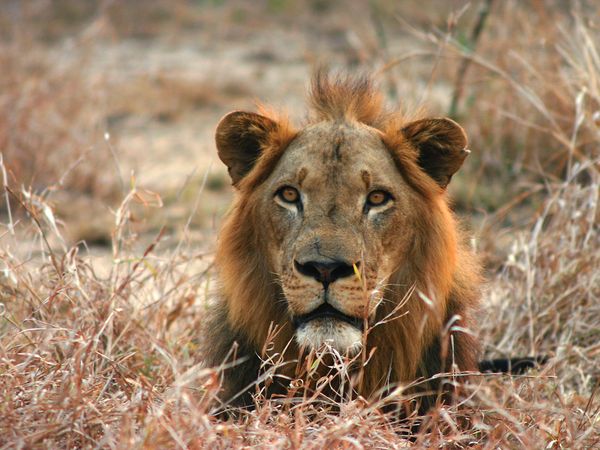The unique combination of features that paint the picturesque landscape of Gorongosa National Park once mapped out dens and territories of one of the densest populations of wildlife in Africa. The four thousand square kilometre Park at the southern end of the Great Rift Valley in the heart of central Mozambique holds within it the abounding valley floor and the peak of Mount Gorongosa, whose rivers irrigate the expansive grassland. An intricate mosaic of varying soil types, intermittently sprouting acacia trees and seasonally waterlogged pans produce distinct ecosystems, which sustain the many members of this gregarious game park. Forested plateaus sink into whitewashed limestone gorges, where spectacularly reaching trees emerge from nourished rain forests, providing a stunning green contrast to pallid cliff faces.
A congregation of grazing herbivores and stealthy predators walked the vast, veined plains beneath a skyful of feathered flocks. An astonishing panthera population used to roam as kings in this area once known as Africa’s Eden, but the crushing beauty of this landscape and the wildlife it supported was wrung dry during an almost two decade long battle that was Mozambique’s prolonged civil war. Mammal populations depleted by as much as ninety five percent and the majestic ecosystems shrunk into famine as Gorongosa was torn apart by the terrestrial conflict. Eventually the Park was shut down and abandoned and its surface was shredded by the frequent tousles that took place between opposing forces. Armed men used every resource to the point of exhaustion as they lived out the years in this wild wonderland. Almighty elephants were slaughtered for their sought after tusks, which served as currency for arms and ammunition; hungry soldiers fed on many thousands of plains game, depleting the populations of zebra, wildebeest and buffalo.
Without the healthy supply of ungulates and antelopes, the glorious lion prides began to dwindle and weaken, as their members starved to death. The weakened remains became easy targets for trophy hunting; a sport adopted by soured soldiers as they mindlessly progressed through an era of devastation. Following a cease-fire agreement in nineteen ninety two, hunting activity surged ahead bringing elephant, hippo, buffalo, zebra and lion populations down to the brink of extinction, where these species numbered only a handful each.
At the very last second, a close shave if there ever was one, the survival of a country’s wildlife was scooped up into the helping hand of non-profit organisation, The Carr Foundation. At this point there were just six remaining lions counted in Gorongosa – a mere fraction of the 200 to 500 that used to lead the empire. The Mozambiquean government shed mercy and joined causes with this U.S.-based organisation in an effort to restore the ecosystem and introduce an ecotourism industry to benefit local communities and rejuvenate the animal kingdom that belonged there. With the injection of funds and specialised breeding programmes, a number of species have been reintroduced to the area and through careful monitoring, are promised to prosper.
The return of royalty to the National Park is the prime focus of Projecto Leões da Gorongosa; an initiative aimed at using applied research, education and strategic partnerships to encourage the growth of the lion community at Gorongosa. Fighting an inevitable death, the six survivors of this population have been protected and guarded sufficiently enough to allow a surge in growth that has brought numbers up to nearly fifty. A victory in itself, this achievement is celebrated and these lions are cherished; however, the exponential growth has stagnated. There is speculation as to why this almighty species has not rebounded at a rate correlated to that of the growing herbivore population and the sustainable hunting conditions; a direction of focus for this conservational initiative.
At the soul of any environmental movement, where dedicated hearts and hands are involved in the saviour of a species, is the involvement and trust of the local communities. Understanding and participation are key, particularly in this case, where the survival of large carnivores could very well conflict with the safety of people in surrounding villages. Projecto Leões da Gorongosa, in close partnership with Gorongosa National Park will help restore this once prolific ecosystem to the refuge it once was for the powerful lion and the community of large carnivores. It is with congratulations and encouragement that we support this project as it commits to working with the local people to foster co-existence in anticipation of the irreversible recovery of the lions of Gorongosa.
To witness benefits of this environmental victory, look no further than Chitengo Safari Camp. It is one of the very few accommodation facilities available in this pristine National Park, and it ensures that it caters for all types of travellers with comfortable, thatched cabanas and charming garden rooms, as well as, having recently renovated a wonderful campsite for those canvas enthusiasts. Chitengo allows for self-drive wildlife viewing, inviting visitors to explore the landscape at their own pace; however, their experienced guides offer an exceptionally valuable tour experience, as they conduct narrated game drives that will inform and enlighten passengers of the wonderment that has become of this war-time veteran.







